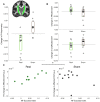Self-modulation of motor cortex activity after stroke: a randomized controlled trial
- PMID: 35960166
- PMCID: PMC9586541
- DOI: 10.1093/brain/awac239
Self-modulation of motor cortex activity after stroke: a randomized controlled trial
Abstract
Real-time functional MRI neurofeedback allows individuals to self-modulate their ongoing brain activity. This may be a useful tool in clinical disorders that are associated with altered brain activity patterns. Motor impairment after stroke has previously been associated with decreased laterality of motor cortex activity. Here we examined whether chronic stroke survivors were able to use real-time fMRI neurofeedback to increase laterality of motor cortex activity and assessed effects on motor performance and on brain structure and function. We carried out a randomized, double-blind, sham-controlled trial (ClinicalTrials.gov: NCT03775915) in which 24 chronic stroke survivors with mild to moderate upper limb impairment experienced three training days of either Real (n = 12) or Sham (n = 12) neurofeedback. Assessments of brain structure, brain function and measures of upper-limb function were carried out before and 1 week after neurofeedback training. Additionally, measures of upper-limb function were repeated 1 month after neurofeedback training. Primary outcome measures were (i) changes in lateralization of motor cortex activity during movements of the stroke-affected hand throughout neurofeedback training days; and (ii) changes in motor performance of the affected limb on the Jebsen Taylor Test (JTT). Stroke survivors were able to use Real neurofeedback to increase laterality of motor cortex activity within (P = 0.019), but not across, training days. There was no group effect on the primary behavioural outcome measure, which was average JTT performance across all subtasks (P = 0.116). Secondary analysis found improvements in the performance of the gross motor subtasks of the JTT in the Real neurofeedback group compared to Sham (P = 0.010). However, there were no improvements on the Action Research Arm Test or the Upper Extremity Fugl-Meyer score (both P > 0.5). Additionally, decreased white-matter asymmetry of the corticospinal tracts was detected 1 week after neurofeedback training (P = 0.008), indicating that the tracts become more similar with Real neurofeedback. Changes in the affected corticospinal tract were positively correlated with participants neurofeedback performance (P = 0.002). Therefore, here we demonstrate that chronic stroke survivors are able to use functional MRI neurofeedback to self-modulate motor cortex activity in comparison to a Sham control, and that training is associated with improvements in gross hand motor performance and with white matter structural changes.
Keywords: motor cortex; neurofeedback; real-time fMRI; stroke; white matter.
© The Author(s) 2022. Published by Oxford University Press on behalf of the Guarantors of Brain.
Figures





Similar articles
-
Transcranial electrostimulation with special waveforms enhances upper-limb motor function in patients with chronic stroke: a pilot randomized controlled trial.J Neuroeng Rehabil. 2021 Jun 30;18(1):106. doi: 10.1186/s12984-021-00901-8. J Neuroeng Rehabil. 2021. PMID: 34193179 Free PMC article. Clinical Trial.
-
Efficacy, safety, and tolerability of bilateral transcranial direct current stimulation combined to a resistance training program in chronic stroke survivors: A double-blind, randomized, placebo-controlled pilot study.Restor Neurol Neurosci. 2019;37(4):333-346. doi: 10.3233/RNN-190908. Restor Neurol Neurosci. 2019. PMID: 31227673 Clinical Trial.
-
Continuous Theta-Burst Stimulation of the Contralesional Primary Motor Cortex for Promotion of Upper Limb Recovery After Stroke: A Randomized Controlled Trial.Stroke. 2023 Aug;54(8):1962-1971. doi: 10.1161/STROKEAHA.123.042924. Epub 2023 Jun 22. Stroke. 2023. PMID: 37345546 Free PMC article. Clinical Trial.
-
Does noninvasive brain stimulation combined with other therapies improve upper extremity motor impairment, functional performance, and participation in activities of daily living after stroke? A systematic review and meta-analysis of randomized controlled trial.Top Stroke Rehabil. 2023 Apr;30(3):213-234. doi: 10.1080/10749357.2022.2026278. Epub 2022 Feb 3. Top Stroke Rehabil. 2023. PMID: 35112659
-
Electroencephalogram-based neurofeedback training in persons with stroke: A scoping review in occupational therapy.NeuroRehabilitation. 2021;48(1):9-18. doi: 10.3233/NRE-201579. NeuroRehabilitation. 2021. PMID: 33386824
Cited by
-
Neurosurgical and BCI approaches to visual rehabilitation in occipital lobe tumor patients.Heliyon. 2024 Oct 11;10(23):e39072. doi: 10.1016/j.heliyon.2024.e39072. eCollection 2024 Dec 15. Heliyon. 2024. PMID: 39687114 Free PMC article.
-
Neural mechanisms underlying the improvement of gait disturbances in stroke patients through robot-assisted gait training based on QEEG and fNIRS: a randomized controlled study.J Neuroeng Rehabil. 2025 Jun 18;22(1):136. doi: 10.1186/s12984-025-01656-2. J Neuroeng Rehabil. 2025. PMID: 40533805 Free PMC article. Clinical Trial.
-
Optimizing spatial specificity and signal quality in fNIRS: an overview of potential challenges and possible options for improving the reliability of real-time applications.Front Neuroergon. 2024 Jun 5;5:1286586. doi: 10.3389/fnrgo.2024.1286586. eCollection 2024. Front Neuroergon. 2024. PMID: 38903906 Free PMC article. Review.
-
Psilocybin-assisted neurofeedback for the improvement of executive functions: a randomized semi-naturalistic-lab feasibility study.Philos Trans R Soc Lond B Biol Sci. 2024 Dec 2;379(1915):20230095. doi: 10.1098/rstb.2023.0095. Epub 2024 Oct 21. Philos Trans R Soc Lond B Biol Sci. 2024. PMID: 39428872 Clinical Trial.
-
Effects of motor imagery-based neurofeedback training after bilateral repetitive transcranial magnetic stimulation on post-stroke upper limb motor function: an exploratory crossover clinical trial.J Rehabil Med. 2024 Mar 7;56:jrm18253. doi: 10.2340/jrm.v56.18253. J Rehabil Med. 2024. PMID: 38450442 Free PMC article. Clinical Trial.
References
-
- Veerbeek JM, Kwakkel G, Van Wegen EEH, Ket JCF, Heymans MW. Early prediction of outcome of activities of daily living after stroke: A systematic review. Stroke. 2011;42:1482–1488. - PubMed
-
- Franceschini M, La Porta F, Agosti M, Massucci M. Is health-related-quality of life of stroke patients influenced by neurological impairments at one year after stroke? Eur J Phys Rehabil Med. 2010;46:389–399. - PubMed

